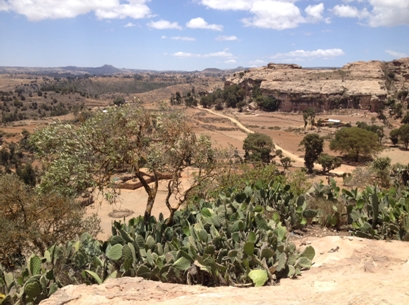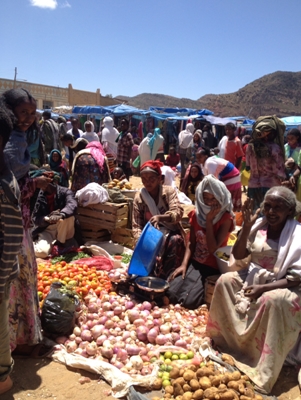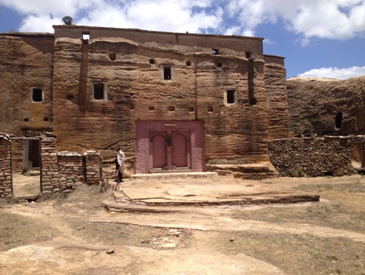Rosie Sells is currently in northern Ethiopia on a G&M-organised tour of the region’s magnificent Christian sites, including Axum, Lalibela, Bahir Dar, and Tigrai. She has been kind enough to keep a diary for us, the first entries of which are published below. Look out for further entries in the coming days.
18th April, Good Friday: Arrival Addis Ababa
Addis Ababa was founded in 1886 by Menelik II and in the relatively short time since has sprung up from nothing into a metropolis of several million, and is still rapidly developing. Occupied by the Italians from 1936-1941, during which time emperor Haile Selassie was in London gathering support to resist the colonial masters, the Italian influence in the capital is strong despite the short five year period of the colony.
Upon arrival we were driven to the Orthodox St. Trinity Cathedral church, Haile Selassie’s burial place, to witness a fascinating Ethiopian orthodox Good Friday service. This annual ritual ran throughout the day and involved continuous genuflection by worshippers who sought to cleanse themselves of sin. The whole-bodied movement itself bore a striking similarity to that of Muslim worship, as did the sound of priest’s song and prayer.
The way in which the congregation were dispersed both inside and outside the church was particularly interesting. This followed no order of hierarchy, although ‘unclean’ women were not allowed inside. Similarly, the relative informality of the proceedings was very noticeable, with some individuals genuflecting intensely and some taking a more relaxed pace, while others wandered around or sat on the floor.
As the service continued we visited a charming museum just behind the church which displayed decorative garments and accessories worn by Selassie. From here we made our way to the Saro Maria hotel, and on to lunch, with more Italian influences evident in the bruschetta, pasta options and Italian wine. Our next stop was the informative National Museum, home of the plaster cast of ‘Lucy’, the 3.2 million-year-old Hominid, and other intriguing cultural and archaeological relics. The museum was also situated within earshot of our Good Friday service, the prayers of which had developed into a powerful electronic-sounding timbre.

19th April, Saturday: Fly to Mekele, drive to Hawzen in Tigrai
The long journey from Mekele to Hawzen took us up and around the hills of Tigrai and past stunning scenery which conjured up images of scenes from the Old Testament. The drive also gave us a chance to hear about the region. Only in the past 20 years has this land been terraced, so as to retain rain water and prevent the return of the famine of bygone years. The terracing has created a contour-like optical effect on the hills which now bear a resemblance to European landscapes in some areas.

Our first stop was a visit to a local market. Local people trickled passed us as they too headed into town, either to buy or sell livestock at the great Easter Saturday market, the biggest in the year. At this particular market, each household buys a cow, a goat and a chicken to slaughter at home in the early hours of Easter Sunday to break their 55-day fast after the vigil on Saturday night.
A slight detour took us to Michael Imba, a magnificently obscure and breathtaking church which dates back to the 5th century, carved into a formidably large rock. After scaling the rock, we passed deep carved pools of holy water and the surrounding monastery buildings to reach this semi-monolithic treasure. The monks, who receive no outside income and live off their share of the food which grows around them, shared with us their fasting food of bread and honey as they prepared for their Easter eve vigil.
After a late lunch in Wukro, we visited Abreha and Atsbeha church. Also a rock-hewn, architectural gem from the 5th century, Abreha and Atsbeha is dedicated to two brothers of these names, who were famous kings of Axum who adopted Christianity in the 4th century. It’s walls bear spectacular murals from the 17th century, which depict the apostles, the saints and allegorical scenes from the bible, and bear a striking similarity to those found in Europe.
The vigils which are held on the eve of Easter Sunday start at 9pm and continue until 3am on Sunday. Welcomed with mild curiosity, but complete acceptance, we attended a vigil at the cave church of Teklehaimanot Hawzien, for what was to be a truly unique and spiritual experience.
Having donned our uniform of white shawls, men and women were separated and we entered the church, and remained, on our respective sides. The service was being led by an unseen figure in the holy of holies (the centre of the small church), to whose calls the worshippers intuitively responded. Four drummers started up a hypnotic rhythm and hand held metal shakers called ‘sistrum’, were handed around for everyone to contribute, others clapped. The members solicitously indicated to us the beat to follow, with a certain degree of amusement. Seemingly spontaneous female ululations also responded to the verse of the priest.
A procession of men began with the lead figures dressed in elaborate, decorative robes, accompanied by the drummers, they circulated the small and compact inside area. Continuing out of the church to the worshippers outside, the volume and tempo gradually increased to an energetic and lively climax. The more diligent members of our group, who saw out the vigil until the end, noted the particular diminution of energy and volume in the final hour as the service took on a more tranquil tone.

